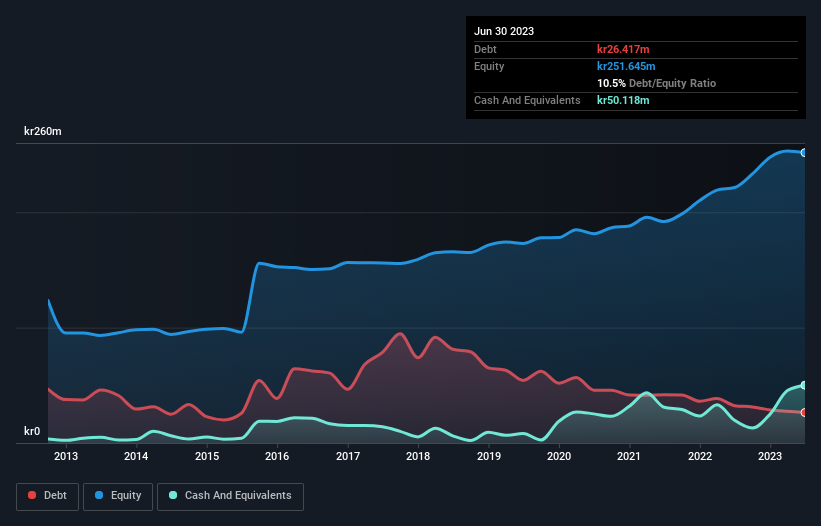
Legendary fund manager Li Lu (who Charlie Munger backed) once said, 'The biggest investment risk is not the volatility of prices, but whether you will suffer a permanent loss of capital.' So it seems the smart money knows that debt - which is usually involved in bankruptcies - is a very important factor, when you assess how risky a company is. We can see that ScandBook Holding AB (publ) (STO:SBOK) does use debt in its business. But is this debt a concern to shareholders?
When Is Debt Dangerous?
Debt and other liabilities become risky for a business when it cannot easily fulfill those obligations, either with free cash flow or by raising capital at an attractive price. Ultimately, if the company can't fulfill its legal obligations to repay debt, shareholders could walk away with nothing. However, a more common (but still painful) scenario is that it has to raise new equity capital at a low price, thus permanently diluting shareholders. Of course, debt can be an important tool in businesses, particularly capital heavy businesses. The first thing to do when considering how much debt a business uses is to look at its cash and debt together.
Check out our latest analysis for ScandBook Holding
How Much Debt Does ScandBook Holding Carry?
As you can see below, ScandBook Holding had kr26.4m of debt at June 2023, down from kr32.4m a year prior. However, it does have kr50.1m in cash offsetting this, leading to net cash of kr23.7m.

How Healthy Is ScandBook Holding's Balance Sheet?
Zooming in on the latest balance sheet data, we can see that ScandBook Holding had liabilities of kr42.4m due within 12 months and liabilities of kr27.9m due beyond that. Offsetting these obligations, it had cash of kr50.1m as well as receivables valued at kr60.2m due within 12 months. So it can boast kr40.1m more liquid assets than total liabilities.
This surplus liquidity suggests that ScandBook Holding's balance sheet could take a hit just as well as Homer Simpson's head can take a punch. On this view, lenders should feel as safe as the beloved of a black-belt karate master. Succinctly put, ScandBook Holding boasts net cash, so it's fair to say it does not have a heavy debt load!
On the other hand, ScandBook Holding saw its EBIT drop by 3.3% in the last twelve months. That sort of decline, if sustained, will obviously make debt harder to handle. The balance sheet is clearly the area to focus on when you are analysing debt. But it is ScandBook Holding's earnings that will influence how the balance sheet holds up in the future. So when considering debt, it's definitely worth looking at the earnings trend. Click here for an interactive snapshot.
Finally, a business needs free cash flow to pay off debt; accounting profits just don't cut it. While ScandBook Holding has net cash on its balance sheet, it's still worth taking a look at its ability to convert earnings before interest and tax (EBIT) to free cash flow, to help us understand how quickly it is building (or eroding) that cash balance. During the last three years, ScandBook Holding generated free cash flow amounting to a very robust 93% of its EBIT, more than we'd expect. That positions it well to pay down debt if desirable to do so.
Summing Up
While we empathize with investors who find debt concerning, you should keep in mind that ScandBook Holding has net cash of kr23.7m, as well as more liquid assets than liabilities. The cherry on top was that in converted 93% of that EBIT to free cash flow, bringing in kr48m. So is ScandBook Holding's debt a risk? It doesn't seem so to us. When analysing debt levels, the balance sheet is the obvious place to start. However, not all investment risk resides within the balance sheet - far from it. For example, we've discovered 3 warning signs for ScandBook Holding that you should be aware of before investing here.
At the end of the day, it's often better to focus on companies that are free from net debt. You can access our special list of such companies (all with a track record of profit growth). It's free.
New: Manage All Your Stock Portfolios in One Place
We've created the ultimate portfolio companion for stock investors, and it's free.
• Connect an unlimited number of Portfolios and see your total in one currency
• Be alerted to new Warning Signs or Risks via email or mobile
• Track the Fair Value of your stocks
Have feedback on this article? Concerned about the content? Get in touch with us directly. Alternatively, email editorial-team (at) simplywallst.com.
This article by Simply Wall St is general in nature. We provide commentary based on historical data and analyst forecasts only using an unbiased methodology and our articles are not intended to be financial advice. It does not constitute a recommendation to buy or sell any stock, and does not take account of your objectives, or your financial situation. We aim to bring you long-term focused analysis driven by fundamental data. Note that our analysis may not factor in the latest price-sensitive company announcements or qualitative material. Simply Wall St has no position in any stocks mentioned.
About OM:SBOK
ScandBook Holding
Manufactures and sells hard/soft cover books for book publishers in Sweden.
Flawless balance sheet with proven track record and pays a dividend.
Market Insights
Community Narratives




